The Black Lion - An aggressive version of the Philidor defence
In the first 10 seconds of the introductory video of one of his latest DVDs, Simon Williams roars like a lion, to pass us that passion which marks his chess, and the aggressive repertoire he wants to teach us. Imagine that happening in front of your eyes! David Nastasio was taken in by Williams' passionate aggression and writes this review on the Black Lion!
The Black Lion - an aggressive version of the Philidor Defence

GM Williams is one of the most funny, passionate, instructive characters in the chess world. I've witnessed his passion for teaching chess in endless videos, and if there would be a competition, a world championship for funniest video teacher, I'm sure he would win it easily.
Williams tells us that he discovered this opening about five years ago when a friend of his introduced it to him. In modern chess, with endless tournaments being played week after week, one definitely needs a varied opening repertoire.
In the first 10 seconds of the introductory video, he roars like a lion, to pass us that passion which marks his chess, and the aggressive repertoire he wants to teach us!

Williams admits after his friend introduced him to this opening he didn't know, he also discovered the wonderful work made by two players who popularized it through the years, in a book one could use as reference:

While for those curious to know more, the book offers a repertoire also against 1.d4. However, Williams throughout the DVD shows the difference of a GM understanding of some positions, and his evaluation, compared to the authors of the book. That is quite important, because one can feel, when playing games between GMs, how some small differences in evaluation can make the difference between a lost game, and a draw. So while he is giving us an aggressive repertoire, he is also solid in his evaluation, and ready to play it at top level!

But here we see Williams in action, because he is always looking for openings, and ways to surprise his opponents, he gives the following move order: 1.e4 d6; 2.d4 Nf6; 3.Nc3 Nbd7...
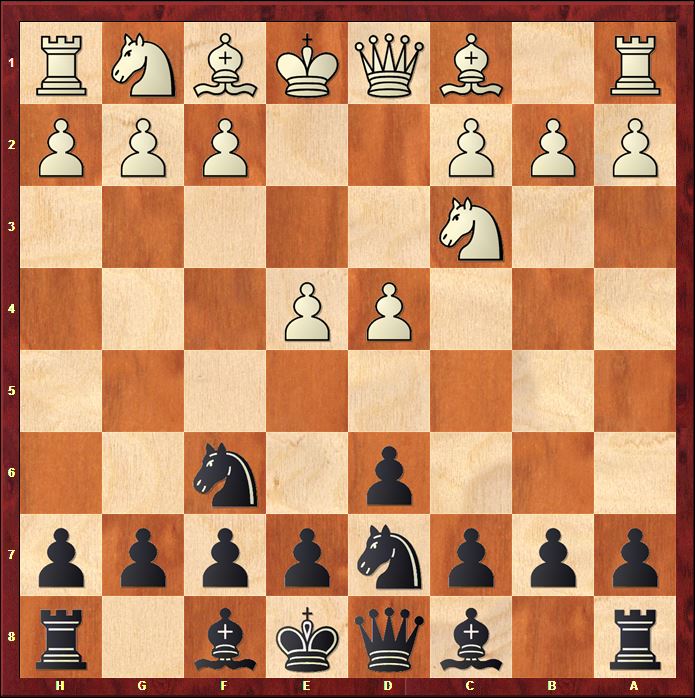
Williams doesn't lose time, and in the introduction begins to explain the plans for Black, when one should castle, and what is the main goal of the opening, like in the following image when he details pawns advancement on the kingside.
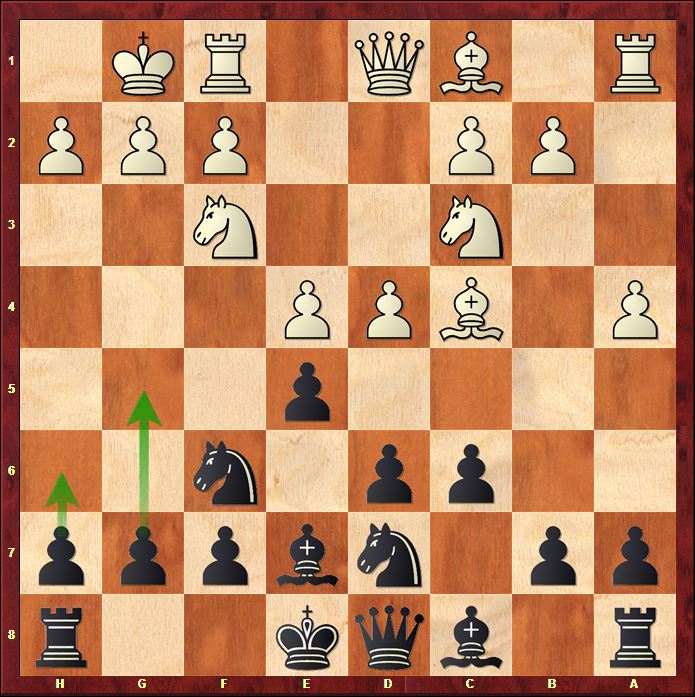

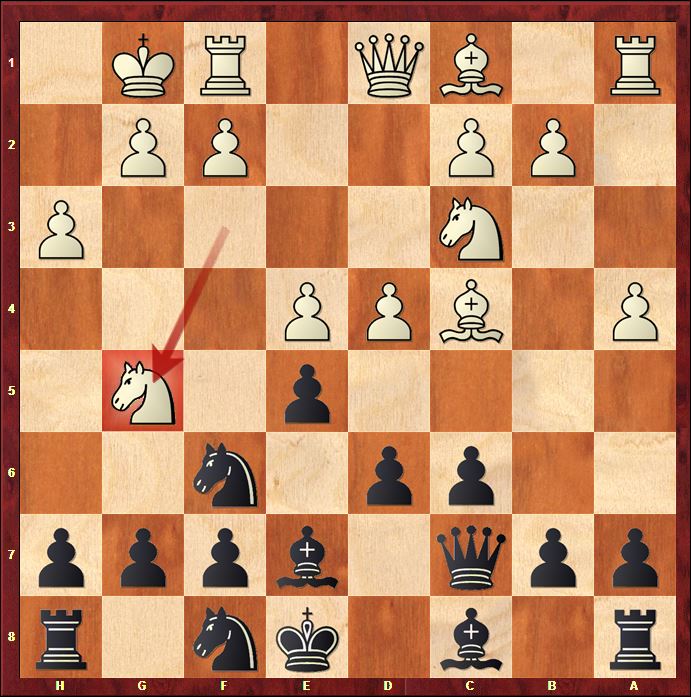
He describes the following position, and the move g7-g5 as "here the lion roars." This is what I will hear during my tournament games, and what will help me guiding through the dark waters of the middlegame. This cannot be given me by a book, and unfortunately, I'm not rich enough to have a trainer 24/7, but I can have GM Williams on a DVD!
Out of the 20 videos which cover every White response, 5 of these videos have games played by Williams, showing us that he definitely played this opening.
But the great surprise came when I began to watch the games in the extra database, many important names have played the Black lion: Carlsen, Morozevich, Ivanchuk, and in my opinion the most important of all, since his name is a brand for creativity: Jobava!
[Site "Warsaw"]
[Date "2010.12.19"]
[Round "13"]
[White "Jones, Gawain C"]
[Black "Jobava, Baadur"]
[Result "0-1"]
[ECO "C41"]
[WhiteElo "2575"]
[BlackElo "2707"]
[PlyCount "76"]
[EventDate "2010.12.18"]
[EventType "rapid"]
[EventRounds "13"]
[EventCountry "POL"]
[SourceTitle "CBM 139 Extra"]
[Source "ChessBase"]
[SourceDate "2011.01.05"]
a5 9. Ba2 h6 10. h3 Re8 11. Be3 Qc7 12. dxe5 dxe5 13. Nh4 Nf8 14. Nf5 Bxf5 15.
exf5 Bb4 16. Qe2 Rad8 17. Qc4 Re7 18. Red1 Rxd1+ 19. Rxd1 Qc8 20. g4 e4 21. Ne2
N8d7 22. c3 Ne5 23. Qb3 Qc7 24. cxb4 Nf3+ 25. Kf1 Qh2 26. Nf4 Rd7 27. Ke2 Ng1+
28. Kf1 Qh1 29. Ng6 Nd5 30. Rc1 fxg6 31. b5 Kh8 32. Qxd5 cxd5 33. fxg6 Rd8 34.
Bxd5 Nxh3+ 35. Ke2 Nf4+ 36. Bxf4 Qf3+ 37. Ke1 Qxf4 38. Rc4 Qd6 0-1
But returning just to the introductory video, I think GM Williams really gave a great overview of the opening, he even showed typical King's maneuvers which are used in place of castling, like the following:
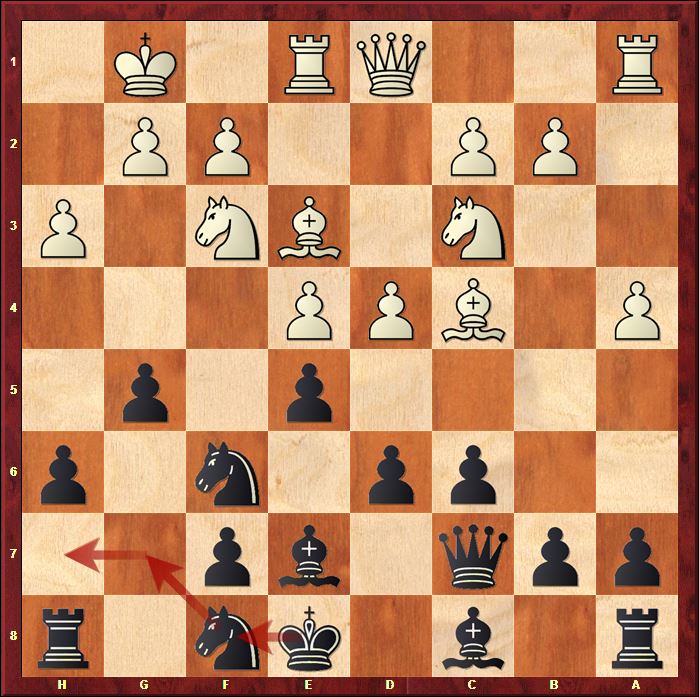
Now let's say I want to have a feeling for this opening, without watching all the videos. Let's say I want to see if this opening is for me. How would I do that?


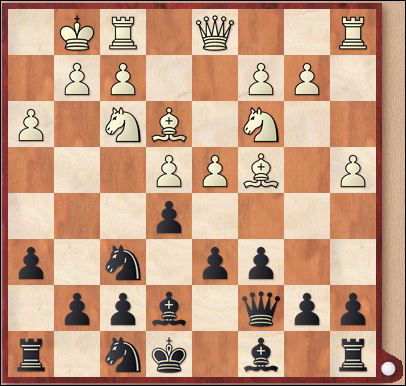
[Site "ICCF email"]
[Date "2008.10.25"]
[Round "?"]
[White "Mer, Alain"]
[Black "Yvinec, Jean-Marc"]
[Result "1/2-1/2"]
[BlackElo "2349"]
[PlyCount "84"]
[EventDate "2008.??.??"]
Be7 9. h3 Nf8 10. Qd3 g5 11. dxe5 dxe5 12. Ne2 Ng6 13. Qb3 Rh7 14. Ng3 g4 15.
hxg4 Nxg4 16. a5 Nf4 17. Qc3 h5 18. Bxf4 exf4 19. Ne2 Bf6 20. e5 Nxe5 21. Nxf4
Kf8 22. Rfe1 Nxf3+ 23. Qxf3 Bg4 24. Qe4 Kg7 25. f3 Bc8 26. c3 h4 27. Rad1 Rh6
28. Re2 Rb8 29. Kh1 b6 30. a6 Bg5 31. Nd3 Rf6 32. f4 Bh6 33. Rf1 Bf5 34. Qe3
Bg6 35. Ne5 Re8 36. Qg1 b5 37. Ng4 Rxe2 38. Bxe2 Rxf4 39. Nxh6 Rxf1 40. Qxf1
Kxh6 41. Qf6 Qg3 42. Bf3 Qe1+ 1/2-1/2
And I do the same for every line GM Williams presents in the DVD, before watching the actual DVD, because in this way I will get a feeling for the opening, and see if I'm compatible with it. In this way, I actually watch 60-80 games, and this will help me to gain the maximum understanding from GM Williams' video lessons.
As always at the end of the DVD there are a series of 19 interactive test videos, where GM Williams presents a position, and ask to find the best continuation, like the following:
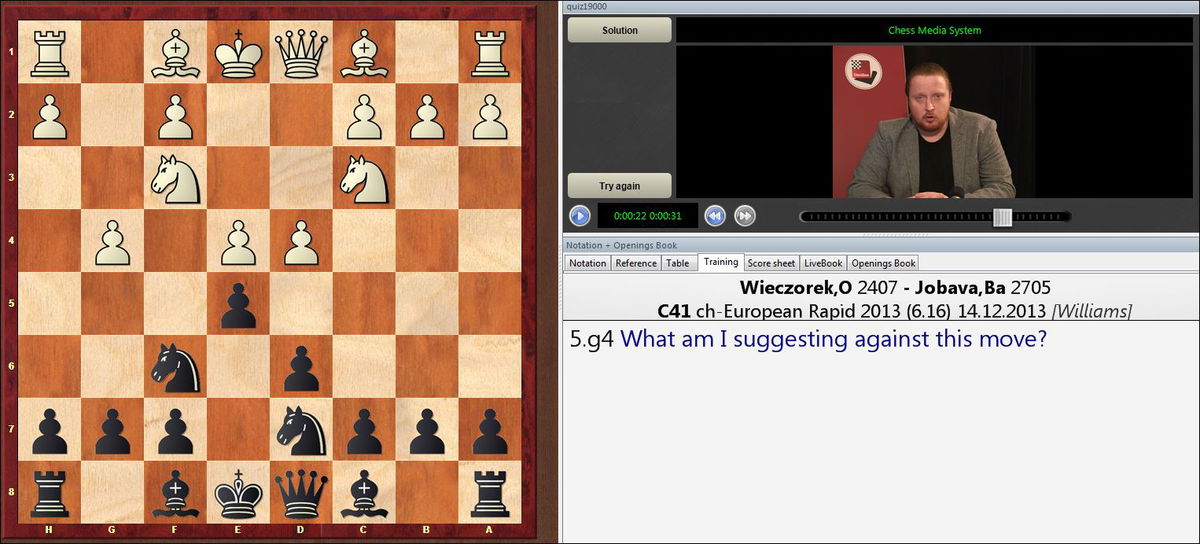
I must confess a sin I made while learning the opening. Generally one should do his homework, which will consist of watching the videos of the DVD, watching the model games from the database given by GM Williams, but I couldn't resist. And I began to play it online in blitz games, and correspondence games, just after watching 2 videos!
In the blitz games it was really fun, because some players didn't understand what hit them, within 35 moves they lost the game. Instead in the correspondence games, I discovered I needed to do my homework! I played at a time control of 24 hours per move. And most of my opponents, maybe because they booked up, did give me some troubles.
Then I finally began to watch all the videos, and discovered GM Williams treated all the lines White played in my correspondence games! However, it was fun, and I just need to be more patient, and play the opening after I watch the videos!
If like me, you have a fire inside and need to play the opening right away watch the videos first, especially the video 11: 1.e4 d6 2.d4 Nf6 3.Nc3 Nbd7 4.Nf3 e5 5.Bc4 Be7 6.Bxf7 Kxf7 7.Ng5+ Kg8 8. Ne6 Qe8 (Rabinovich, I- Ilyin-Zhenevsky, A).
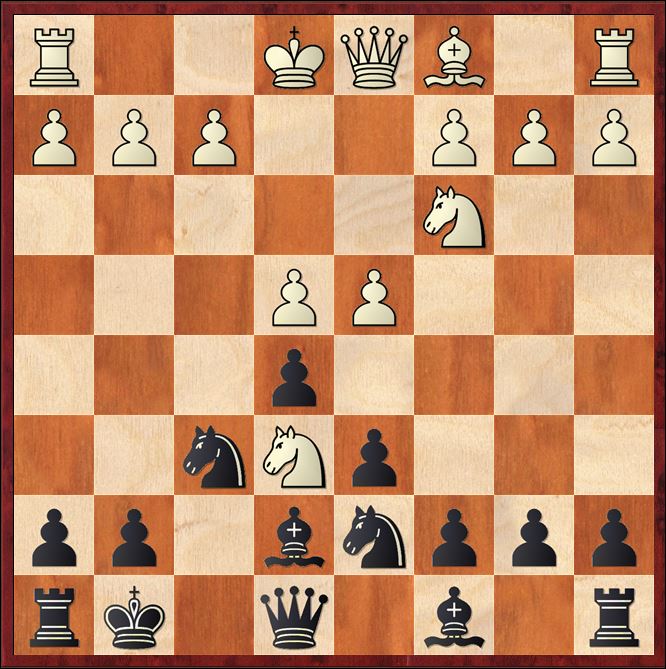
...and video 12: 1.e4 d6 2.d4 Nf6 3.Nc3 Nbd7 4.Nf3 e5 5.Bc4 Be7 6.Ng5 0-0 7.Bxf7 Rxf7 8.Ne6 Qe8 (Radulski,J-Mchedlishvili,M)

The videos 13 and 14 will blow your mind, if you really love aggressive chess!
Here an example from video 13: 1.e4 d6 2.d4 Nf6 3.Nc3 Nbd7 4.f4 e5 5.Nf3 exd4 6.Qxd4 c6 7.Be3 d5 8.exd5 Bc5 (Dastan,B - Laznicka,V).

In these two videos, Williams shows his great teacher side. He knows one needs to remember the lines, and while he explains them giving the rationale for most moves, at the end of the video he also recapitulates all the most important points, in order to give the student the maximum chance to remember, especially if one pays enough attention. Otherwise, it is possible to watch the video a couple of times to cement in memory the moves one must remember.
Williams also shows a lot of middlegame themes and ideas on how to attack the enemy king.
I don't want to spoil all the surprises inside this DVD, detailing too much, but I think it could be useful also for a beginner, because often beginners make the mistake to play solid openings, instead it is essential to learn gambits, or how to attack sacrificing a pawn. This DVD, through GM Williams, shows that, and it is quite a priceless lesson.
In conclusion: this DVD made me want to learn this opening, and use it in my games as soon as possible. I like the top players who play it, and I find it quite aggressive, which is what I need in a game as Black since I always play for a win!
About the Author

Davide Nastasio is a novel chess aficionado, who has made of chess his spiritual tool of improvement, and self-discovery. One of his favorite quotes is from the great Paul Keres: "Nobody is born a master. The way to mastery leads to the desired goal only after long years of learning, of struggle, of rejoicing, and of disappointment..." He is one of the main writers for ChessCafe on Chessbase products, he authors articles on British Chess Magazine, and he is one of the main contributors of Georgia Chess Magazine in the new electronic format: Georgia Chess News. He is an active player, and organizes and directs chess tournaments.
